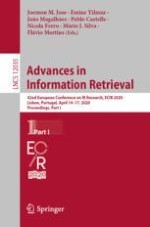This two-volume set LNCS 12035 and 12036 constitutes the refereed proceedings of the 42nd European Conference on IR Research, ECIR 2020, held in Lisbon, Portugal, in April 2020.
The 55 full papers presented together with 8 reproducibility papers, 46 short papers, 10 demonstration papers, 12 invited CLEF papers, 7 doctoral consortium papers, 4 workshop papers, and 3 tutorials were carefully reviewed and selected from 457 submissions. They were organized in topical sections named:
Part I: deep learning I; entities; evaluation; recommendation; information extraction; deep learning II; retrieval; multimedia; deep learning III; queries; IR – general; question answering, prediction, and bias; and deep learning IV.
Part II: reproducibility papers; short papers; demonstration papers; CLEF organizers lab track; doctoral consortium papers; workshops; and tutorials.
